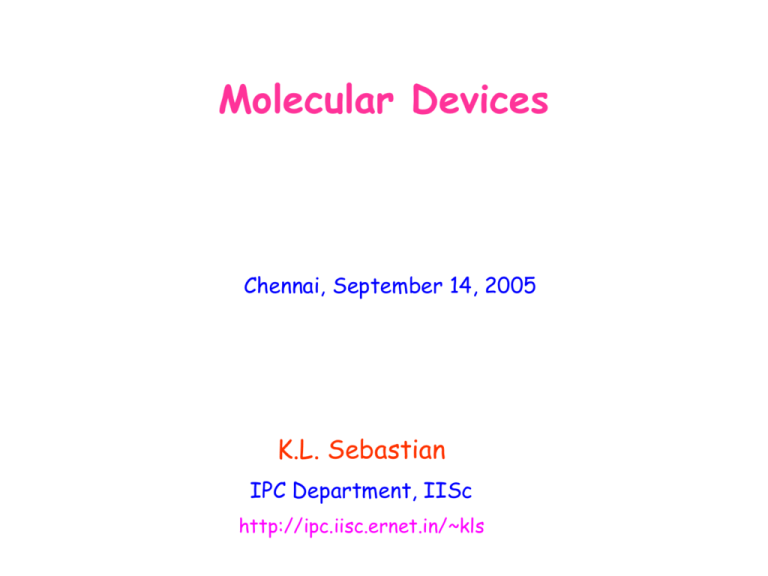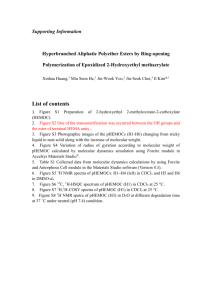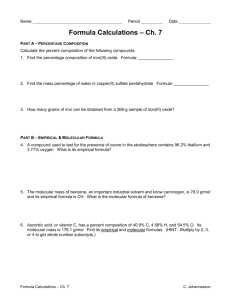Molecular Devices
advertisement

Molecular Devices Chennai, September 14, 2005 K.L. Sebastian IPC Department, IISc http://ipc.iisc.ernet.in/~kls Outline • Motivation – examples from biology • Molecular Rollers and Rocker • Molecular Wheel • Molecular Rattle . Fluxionality for Rotational Motion • Nature does it very well! (Biological Molecular Motors) • Synthetic Molecular Motors • Light driven molecular motor Is that a flower? It is a motor Height ~ 8 nm Width ~ 10 n MOLECULAR Can one design molecules that would prefer to roll on a surface? What do you mean? ROLLER Seems rather difficult, perhaps we can try to use fluxionality! Consider Hypostrophene-it is fluxional -perhaps we can use this property! God! He crazy!! is To explain, let us start with Pentaprismane H Pentaprismane (C10H10) D5h hypostrophene Hypostrophene C2v pentaprismane Symmetry is broken! It can be broken in FIVE different ways! Five degenerate minima! It should be possible to jump from one to the other It does! Known as Degenerate Cope Rearrangement Degenerate Cope Rearrangement for Hypostrophene Activation energy B3LYP/6-31G** (kcal/mol) 25.31 GS TS Rate constant Rate constant ~ 1.8 X 10-5 sec-1 Activation energy Q and Q* are the partition functions of GS and TS Think of Hypostrophene adsorbed on Al(100) Rolling Motion Rolling-TS Eact ~ 18 kcal/mol Translation-TS: Eact ~ 65.5 kcal/mol Molecular Roller Same thing can happen with syn-TOD! Cubane Syn-TOD C2v Td Activation energy B3LYP/6-31G** (kcal/mol) GS TS 24.25 Activation energy 13.6 kcal/mol (B3LYP/6-31G** C,H and 321G for Al) TS MOLECULAR ROLLERS We conclude that: Hypostrophene and tricyclooctadiene when chemisorbed on Al(100) surface should behave as ‘Molecular roller’ Bidisa Das, K.L Sebastian, Chemical Physics Letters, 330, 433 (2000). MOLECULAR ROCKER Cope Rearrangement of Semibullvalene GS GS TS Activation energy B3LYP/6-31G** (kcal/mol) 5.5 Semibullvalene on Al(100) Metal surface: cluster of 14 or 32 Al atoms in two layers Hydrogen atoms at the edges. B3LYP/Al:3-21G, C,H:6-31G** Ea = 21.8 kcal/mol MOLECULAR ROCKER Fluxionality for Rotational Motion Fe(CO)3 Fe(CO)3 moving around hypostrophene Hypostrophene 203i cm-1 4.3 kcal/mol 33.6 kcal/mol Molecular wheel MOLECULAR WHEEL C5H5Ge(CH3)3 is known to be fluxional! Eact ~ 16.0 kcal/mol The activation barriers and rate constants Eact (kcal/mol) rate constant at 298.15 K (sec-1) Si (C,H: 6-31G** & Si: 6-31G**) 14.04 3.2X102 Ge (C,H: 6-31G** & Ge: 6-31G**) 12.21 1.6X103 Sn (C,H: 6-31G** & Sn: 3-21G) 5.74 3.7X108 M atom bonded to Cp and basis-sets used Cyclopentadienyl adsorbed on Ge surface, should move like a wheel! Hopping onto adjacent Ge atoms Adsorbed to the same site! Eact ~ 11.9 kcal/mol M atom bonded to Cp and basis-sets used Eact (kcal/mol) Rate constant (sec-1) 298.15 K Si (C,H: 631G** & Si: 6-31G**) 13.45 8.5X102 Ge (C,H: 631G** & Ge: 6-31G**) 11.90 1.9X104 Sn (C,H: 631G** & Sn: 3-21G) 5.97 2.5X108 Molecular Wheel That is not bad! Why don’t you call it a molecular “seal”? Sn Ea = 5.97 kcal/mol B. Das and K.L. Sebastian: CPL 357, 25 ( 2002) We conclude that : The cyclopentadienyl co-adsorbed with hydrogen on Si/Ge/Sn (111) surfaces would form a system where the five membered ring can undergo spinning motion with low activation energies. Bidisa Das, K.L Sebastian, Chemical Physics Letters, 357, 25 (2002). Molecular Rattle A B B A B A H H H+ - H H H H Does not happen! Ionization potential of H too large! Perhaps, in an excited state, this might happen H+ Replace H with Li! Li+ - Ring too small - Li+ Eact~42.4 kcal/mol Eact a:315 kcal/mol b:36.6kcal/mol c:33.6kcal/mol These are the molecules that we studied but activation energies for the ‘umbrella inversion’ kind of motion was found to be high. M. Oda, Pure & Appl. Chem. 58, 7 (1986), T.Z. Ktaz, P. A. Garratt, J. Am. Chem. Soc. 85, 2852 (1963). C9H9- Molecular Rattle Ea = 11.7 kcal/mol B. Das and K.L. Sebastian: CPL, 365, 320 (2002) Proton going through benzene (C6H7+) Mahapatra, Sathyamurthy, Current Science, 1995 Cyclononatetraenyllithium The activation barrier for the ‘umbrella inversion’ in this case is ~11.5 kcal/mol Normal mode analysis: 276 cm-1(GS), 274i cm-1(TS) 1D through ring motion calc.: 277 cm-1(GS), 267i cm-1 (TS) Nature does it well! Biological Molecular Motors We know of several, efficient molecular motors! All of them occur in BIOLOGICAL systems Figure from: http://ccgb.umn.edu/~mwd/cell.html Energy from photosynthesis Figures and animation from: http://www.sp.uconn.edu/~terry/images/anim/ATPmito.html ATP Synthase (Rotary) Most powerful known motor ATP Synthase Synthesizes ATP. Rotates while it does this! Kinesin (Walker) Proteins that WALK! Works like a PORTER at the railway station See animation at http://mc11.mcri.ac.uk/wrongtrousers.html Myosin Proteins that PUSH! Myosin For an animation, see the CD of the book: Molecular Biology of the Cell by B. Alberts et. Al. See also: http://www.rpi.edu/dept/bcbp/molbioch em/MBWeb/mb2/part1/myosin.htm Synthetic Molecular Motors NO WAY near the natural ones! shuttle station station Rotaxane stopper Electron Removal +e -e Proton Addition - H+ + H+ Either electron removal or proton addition Catenanes 2-catenane 3-catenane Switching by Oxidation-Reduction Reations -e +e Catenanes – how to have light driven motor? station shuttle Leigh et. al. Nature, 424, 174 (2003) Excitation of the station leads to unbinding! Light induced excitation of the shuttle is better! K.L. Sebastian: Current Science, 87, 232 (2004) Can one have……? Light induced conformational change driving translation! Cis-trans isomerization as in Azobenzene could be useful Molecular Ratchets, Second Law and Detailed Balance Brownian motion would drive the ratchet! But it can rotate only in one direction! So thermal, random motion can be used to drive the ratchet in one direction! Axle [4]helicene triptycene A molecular ratchet was Synthesized and studied by Kelly et. al. Angewandte Chemie 109, 1969 (1997). It can undergo ratchet-like internal rotation! To probe rotational motion use NMR That is clever! Second Law verified! But wait! Let us think about this! There he goes! As mad as a coot! The fact that you can see rotation means that your initial state is a non-equilibrium one! So even if you had seen net rotation, that would not violate the second law! But you do not see any net rotation! What does that mean? Because of Detailed Balance! K.L. Sebastian, Physical Review E61, 937 (2000) CONCLUSIONS Molecular Roller, Wheel, Rocker, Rattle! Fluxional behavior can be used to get interesting mechanical motion Ratchets, Light driven motor…… Acknowledgements Dr. Bidisa Das Prof. Ashoka Samuelson






